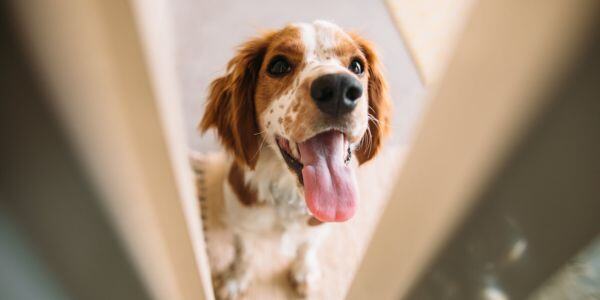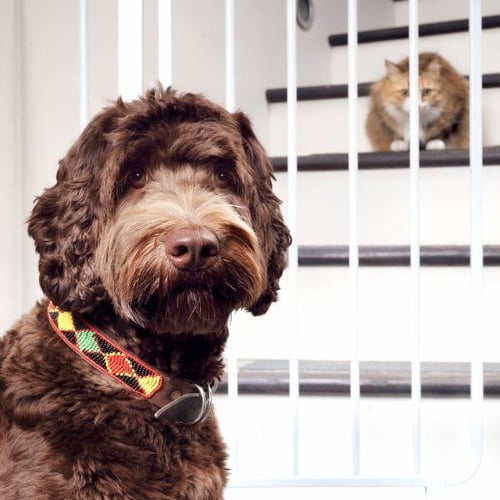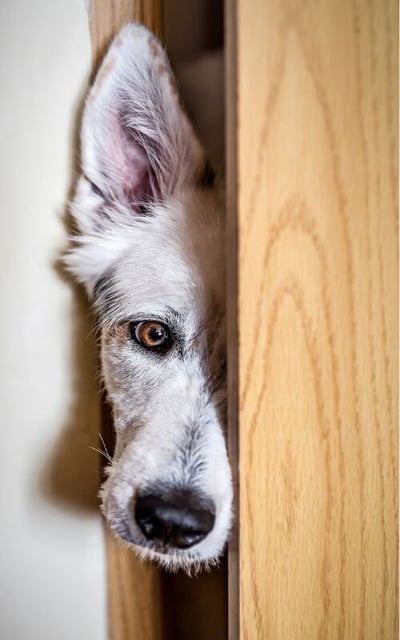 If you’ve got cats and dogs, you’ve likely fought the battle to keep your dogs from “helping” you keep the cat’s litter boxes clean — yes?
If you’ve got cats and dogs, you’ve likely fought the battle to keep your dogs from “helping” you keep the cat’s litter boxes clean — yes?
Perhaps you’re still fighting the battle?
Maybe you’ve given up?
Take heart, though, intrepid warrior; all hope is not lost. There can be ways to win this war — and, in the process, minimize your cat’s stress, as well as your dog’s digestive upset.
Why Do Dogs Eat Cat Poop?
No one knows for sure. It's most likely because, by nature, dogs are scavengers, and it tastes like yummy cat food. And anyone who's had a dog knows that most dogs will eat anything given the opportunity!
Is Cat Poop Dangerous For Dogs?
It certainly can be! Not only can eating cat poop cause digestive upset for dogs, but it can also be a source of transmission for harmful parasites (e.g., roundworms and bacteria like salmonella). Ouch, and yuk (especially if your dog licks your face)!
If parasites and bacteria aren’t bad enough, your dog could end up with an intestinal blockage if they consume too much kitty litter; this is especially a concern for clumping kitty litter.
Note: Many clumping litters contain a compound called sodium bentonite. There is a case of suspected bentonite toxicosis in a cat that ingested clay litter. This makes the ingestion of clumping litter for smaller dogs a bigger concern. The cat with this suspected condition had lethargy, muscle weakness, anemia, and hypokalemia (low blood potassium).
Lastly, some dogs can have an allergic reaction to some of the artificially scented litters.
Signs and Symptoms If Your Dog Has Eaten Cat Poop
- Lack of appetite
- Painful abdomen
- Decreased energy
- Vomiting
- Diarrhea
- Straining to poop
- Constipation
- And then, of course, bad breath and cat litter between their teeth

How to Keep Your Dog Out of the Litter Box
Training your dog not to eat cat poop is not easy or even possible for some dogs, so keeping your dog separated from the litter box is the only option.
Cats are carnivores, and dogs aren't, so because there's a high amount of protein in cat food and treats, it may make it even more tempting for your dog to resist. The struggle is real!
Try these separation tips instead:
1. Put litter boxes in rooms or a level of your home behind a baby gate.
If you’ve got a large dog, elevate the baby gate a few inches off the ground — high enough that your cat can shimmy under, but your dog will be left looking in.
You can also try a baby gate with a small pet door that your cat can walk through. Or, for larger dogs, you may be able to find a gate with bars far enough apart that your cat can easily step through but not large enough that your dog gets their head stuck! Ideally, you never want your cat to have to struggle to get to their litter box.
If your dog is as small as your cat, then lower the gate to the ground and try putting a cat climbing tree on either side of the gate — this will give your cat an easy path to the box while your dog can just sit and admire your cat’s nimbleness.
2. Use a gate hook and eye or a door latch specifically for this issue (two options are listed below) to prop your basement, bathroom, or closet door open wide enough to allow your cat to pass in and out* while keeping your dog out.
*Won’t work if your dog is the same size as your cat.
Door Buddy Door Prop – adjustable strap length

3. Install a cat door, such as the Cathole or if your dog would be small enough to pass through it, install a microchip door so only your cat can go through.
4. Put a litter box behind a piece of furniture, blocking off your dog’s access with a strategically placed baby gate. Just remember that your cat will feel more secure if they have open sightlines when using the box, so try not to tuck them too far behind furniture.
5. You can create a litter box area using a foldable dog fence like this one.
6. Elevate the litter box. You can put it on a table or piece of furniture. You can even create something special, like a built-in shelf or a nice cabinet with the box on top and your supplies inside. Just be sure your cat has a few steps they can use to get up to the box. And they should be able to step onto the elevated surface and then into the box.
You don’t want them to have to jump from the ground or step directly into the box. This option isn’t great for cats with mobility issues like arthritis.
Put the litter boxes up on a laundry table or countertop that your dog can’t reach. Just be certain that your cat can easily and comfortably reach the boxes — especially for older cats who may be suffering from arthritis or other painful conditions.
7. Put the litter box in an enclosure, like a cabinet. Just be aware, though, that most cats prefer uncovered litter boxes, and that preference will be even stronger if each time they try to exit the covered box, they’re greeted by your dog’s smiling face. You can minimize the likelihood of this happening by making several entrances and exits for your cat to choose from.
8. As a last resort, you can consider a covered litter box. Just like an enclosure, covered boxes limit your cat’s sightlines, making them feel less safe.
Covered boxes are also usually way too small for a cat to use comfortably. Your best bet is to make your own litter box with a very large, clear storage container. Ideally, the entry should be on the side. You can add a second entry on the other side to make it feel a bit safer.
Keep in mind that covered boxes create a game of whack-a-mole, and your cat's the mole, especially is they have only one exit out of the box. What's more exciting to a playful dog (or another cat) than something they can or can't see inside a box making a noise? Often, the enclosed nature of the box can make it more appealing for other pets to stalk and bother the cat who's in the box.
Things to Avoid
-
A top-entry box will keep your dog out. But be advised, most cats really don’t love this style. It can cause stress and other issues, like house soiling. This is especially true if your cat has any challenging relationships with other pets in the home, even if it’s just your young dog being a bit too playful for their liking. If this is the case, try some of the other dog-proofing options.
-
Putting all of the litter boxes in the garage, patio/balcony, or sunroom. Weather and noise can be a factor in all of those locations, and outdoor cats can smell the box and respond by spraying nearby, which can cause issues for your cat. It’s also important to spread litter boxes throughout your home.
-
Building an outdoor litter box with an entry from inside the home. This is the same as an enclosed litter box, with the added stress of weather, sound, and issues with outdoor cats.
-
Putting all the boxes in the basement, where the dog doesn’t want to go. If it’s a dark, unfinished basement, odds are the cat doesn’t want to go down there either
- Toilet training your cat – don't do it! It's a completely unnatural experience and body posture for a cat. And it's something a senior cat or one with mobility issues won't be able to do. Read more about why toilet training your cat isn't ideal.
Most of us are not lucky enough to have a cat that sings a poop song every time he does his business like Mazel. This habit started when he was a kitten and was either developed to let his dog brother know a "snack" was waiting for him, or he was letting his mom know he was done and it was time to clean up.
Usually, the "poop song" lasts a bit longer but was cut off since his mom was right there filming and ready to scoop.
It’s a noble quest you’re on! The stress of sharing their litter boxes with the slobbery canine residents of the household can cause your cats enough stress to bring on urinary problems. And the frequent litter box raiding will almost certainly cause your dog digestive upset.




